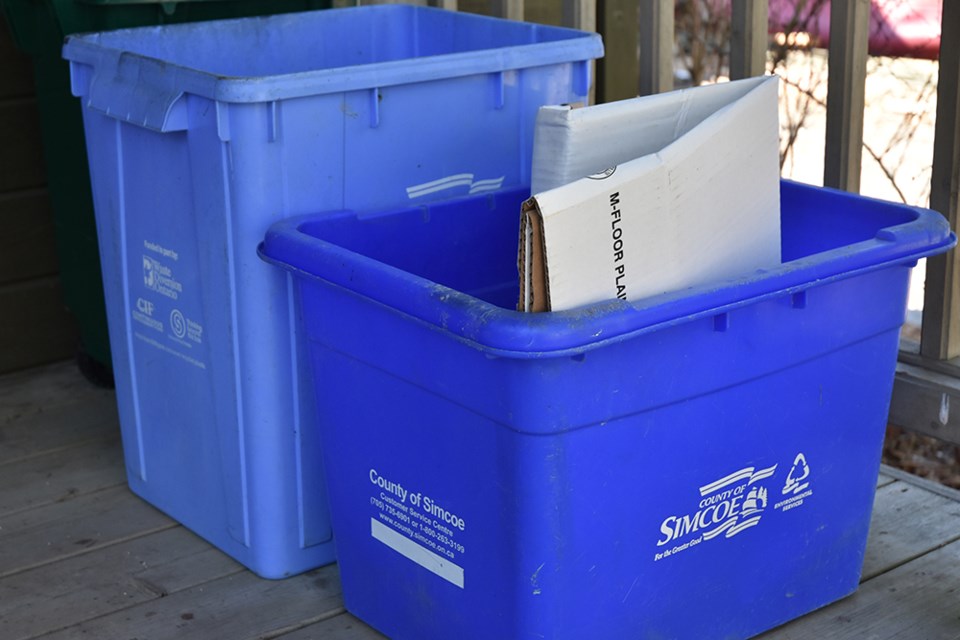As landfills reach capacity and more garbage is exported away from the regions that generate it, municipal and provincial governments are planning more diversion efforts to reduce the load on landfills.
In our region, Simcoe County collects garbage, organics and recycling at the curb every week, in addition to the occasional collection of textiles, batteries, hazardous waste, and leaf and yard waste.
These programs have contributed to a 53 per cent diversion rate for curbside collected waste in the county, according to the annual report on waste management released by Simcoe County.
At the collection facilities, the waste diversion rate is 70 per cent, a result of having those dropping loads off sort them into various piles.
Yet the waste diversion rates for industrial and commercial waste has remained stagnant.
According to Wilma Bureau, collections and contracts supervisor for the county, a recent study showed 32 per cent of businesses surveyed put out some form of recycling, and just seven per cent put out organics.
The county isn’t mandated to provide curbside collection to industrial or commercial properties, but in some cases - like Collingwood’s downtown - there are businesses served by the garbage and recycling collection trucks.
“The province is trying to get a better handle on what is going on in the commercial and industrial sectors, and residentially waste diversion has been going well,” said Bureau.
“In particular, [the province] is interested in organics. Where that will land in the end I don’t know for sure. They’re certainly paying it more attention. Hopefully that will result in more organics being diverted.”
Currently, the collection limits for businesses are the same as they would be for residential units. One bag of garbage, six compost bins, cardboard tied in bundles, recycling sorted into blue and grey bins.
“I understand for a larger business, a bag of garbage a week is not going to cut it,” said Bureau. “Certainly I wish we could help everybody.”
In late 2016, Ontario proclaimed the Waste-Free Ontario Act, comprising the Resource Recovery and Circular Economy Act and the Waste Diversion Transition Act.
At the heart of the legislation was the idea that producers should be responsible for the end-of-life management of their products and packaging.
Under the current Blue Box Program, producers are responsible for shouldering about half the cost of recycling across the province.
Earlier this summer, the Ontario government announced it was pursuing a plan to make producers responsible for 100 per cent of recycling in the province.
The county’s current collection service levels were built around what municipalities did before the county took over waste collection. There were 16 different municipalities added to the county’s service, and 16 different ways collections were managed.
There are some homes in Collingwood without garbage collection service. The county does not offer waste collection at any multi-storey residential building, any condominium complex with condominium roads that are not accessible for collection vehicles, and some cottages where roads are not accessible.
“As long as we can access them safely, we provide service,” said Bureau. “If we can service it, we’re happy to. It’s better for everybody, it’s more efficient.”
Bureau said those residents who do not receive curbside collections receive a rebate on their taxes for the portion that would normally cover waste collection.
Waste collection becomes the responsibility of the condo owners, and level of service depends on their preference.
The Collingwood landfill site does allow residents to bring organics and sorted recycling to the facility at no charge.
The site, located on the 10th Line, has a remaining lifespan of about six years, according to the County’s annual report.
The Collingwood site is one of three remaining operating landfills with Nottawasaga and Oro. The latter two sites have a combined remaining lifespan of nine years. There are still five other active drop-off waste receiving sites in the county.
There are 145,000 units in the Simcoe County curbside collection service area. Approximately 60 per cent of the county’s curbside collected garbage is exported out of Simcoe County.
The county has proposed an Environmental Resource Recovery Centre on Horseshoe Valley Road West in Springwater, where the county would manage its own waste, and run an organics processing facility.
